

|
|
|
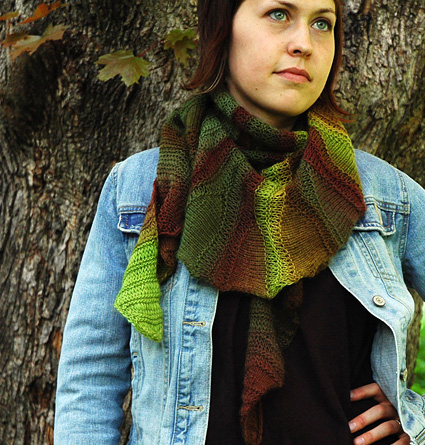 |
Seasons change quickly on the edge of the Great Plains. A 50-degree day in late September is chilly, in March it feels like freedom. Light wraps are always welcome for snuggling into for extra warmth either way. Initially designed to take advantage of slow striping sock yarn, Coquille was so much fun that other fingering and sock weight yarns got into the act. The gussets on this wrap, worked side to side, reminded me of a scallop shell. The lacy look is created by using two different size needles, a smaller one suited to the yarn weight, and one about 6 sizes larger. The short rows that create the gussets would be perfect for those venturing into short rows for the first time, since the shaping makes it easy to see what is happening. |
| This stitch pattern is so obvious, you can tell where you are in the pattern by counting the gussets -- 3 small, 5 or 7 medium, 5 or 7 large, 3 extra large, then back again. (I’m lazy, and prefer projects that don’t require much counting.) Coquille works up quickly, and only requires 400 yards of fingering weight for the small size, and 610 yards for the large. Perfect for gift giving, no matter what climate you live in, or what boreas or zephyrus blow your way. | |
|
|
|
|
SIZE |
|
FINISHED MEASUREMENTS |
|
MATERIALS Note: If substituting yarn, small size requires approx.
400y/366m and large size requires
approx. 775
y/710 m of fingering
weight yarn. Yarn requirements may
vary according to gauge obtained during
knitting; gauge given is for pattern
after blocking. Notions |
|
GAUGE |
| 24
sts = 4” in stockinette st
using smaller needle, after blocking 20 sts = 4” in stockinette st using larger needles, after blocking 30 rows = 4” in pattern using both needle sizes as directed, after blocking Note: Exact gauge is not critical for this pattern. Row gauge over pattern is not measured over short-rowed section. |
|
PATTERN NOTES |
|
W&T (Wrap & Turn): Knit to point specified in pattern,
bring yarn to front of work between needles, slip next stitch to
right-hand needle, bring yarn around this stitch to back of work,
slip stitch back to left-hand needle, turn work to begin purling
back in the other direction. inc1: The increase used for this pattern
is the backward loop increase. It is the first increase
shown here,
referred to as m1. yf: Bring yarn between needles to front of work. All slipped sts in this pattern are slipped purlwise. |
|
DIRECTIONS 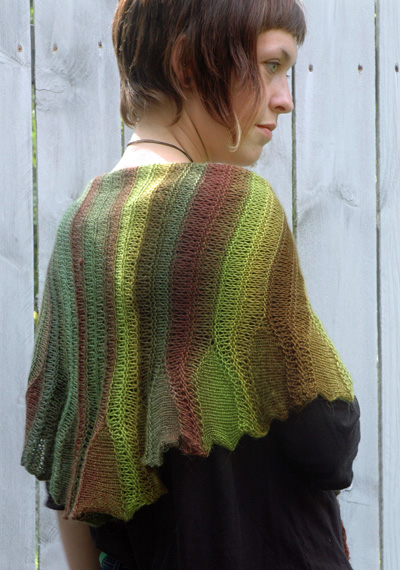 Using smaller needle, CO 3 sts. Row 1 [WS]: K3. Row 2 [RS]: [K1, inc 1] twice, k1. 5 sts. Row 3 [WS]: K5. Row 4 [RS]: K2, [K1, inc 1] twice, k1. 7 sts. Row 5 [WS]: K2, [inc 1, k1] four times, yf, sl 1. 11 sts. Row 6 [RS]: K2, inc 1, k to last st, yf, sl 1.
12 sts. SECOND SECTION (Small Gussets) Row 1 [RS]: Using smaller needle, k2, inc 1, k to last
st, yf, sl 1. 18 sts. Short Rows: Rows 3-4: Work as for Rows
1-2. 19 sts. Repeat Rows 1-12 twice more. 29 sts.
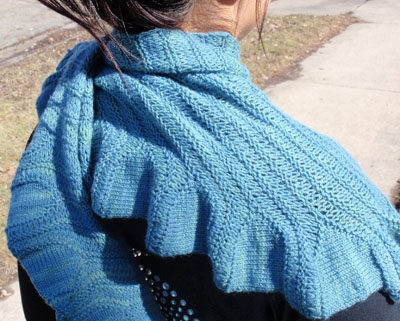 (Mid-sized Gussets) Row 1 [RS]: Using smaller needle, k2, inc 1, k to last st, yf, sl 1. 30 sts. Row 2 [WS]: K to last st, yf, sl 1. Short Rows: Rows 3-4: Work as for Rows
1-2. 31 sts. Repeat Rows 1-12 four[six] times more. 49[57] sts. FOURTH SECTION (Large Gussets) Short Rows: Rows 3-4: Work as for Rows
1-2. 51[59] sts. Repeat Rows 1-12 four[six] times more. 69[85] sts.
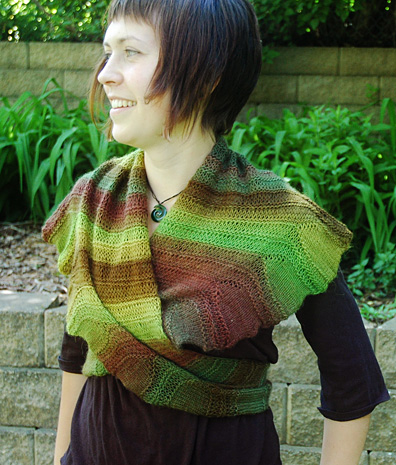 Row 1 [RS]: Using smaller needle, k2, inc 1, k to last st, yf, sl 1. 70[86] sts. Row 2 [WS]: K to last st, yf, sl 1. Short Rows: Rows 3-4: Work as for Rows
1-2. 71[87] sts. Repeat Rows 1-12 once. 77[93] sts. This is the center point of the shawl. You will now begin working decreases on RS rows, instead of increases. SIXTH SECTION (Final Largest Gusset) Work Short Rows as for Fifth Section. Rows 3-4: Work as for Rows
1-2. 75[91] sts. SEVENTH SECTION (Large Gussets) Work Short Rows as for Fourth Section. Rows 3-4: Work as for Rows
1-2. 71[87] sts. Repeat Rows 1-12 four[six] times more. 53[61] sts. EIGHTH SECTION (Mid-sized Gussets) Work Short Rows as for Third Section. Rows 3-4: Work as for Rows
1-2. 51[59] sts. Repeat Rows 1-12 four[six] times more. 33 sts for both sizes. NINTH SECTION Work Short Rows as for Second Section. Rows 3-4: Work as for Rows
1-2. 31 sts. Repeat Rows 1-12 twice more. 21 sts for both sizes. TENTH SECTION Row 7 [RS]: [K2, k2tog] three times, k1, k2tog. 11 sts. |
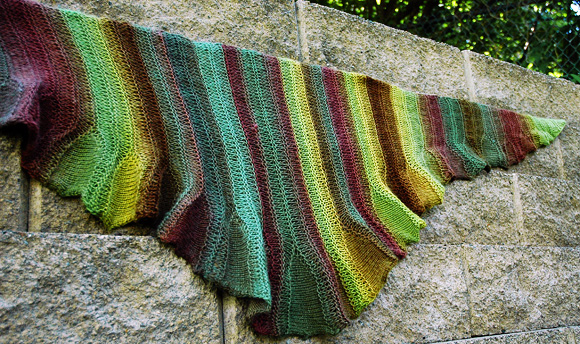
|
|
FINISHING |
| ABOUT THE DESIGNER |
|
|
|
Pattern & images © 2010 M.L. Egan. Contact Mary Lou |